一、目标任务概述
这里记录了一下一个多线程定时作业的实现流程,任务目标是每天半夜1点执行定时作业,把当天产生的记录,进行批量计算处理,之后在更新回数据库。所以从代码里面抽出来从项目创建开始写了个小demo,进行了一下整理和记录以备忘。
这里的主要环境和工具如下:
IntelliJ IDEA 2021.2.3
JDK8
Mysql5.7
Postman
Navicat Premium
spring-boot 2.6.7
mybatis 2.2.2
二、项目创建
打开idea,创建一个新项目,截图如下
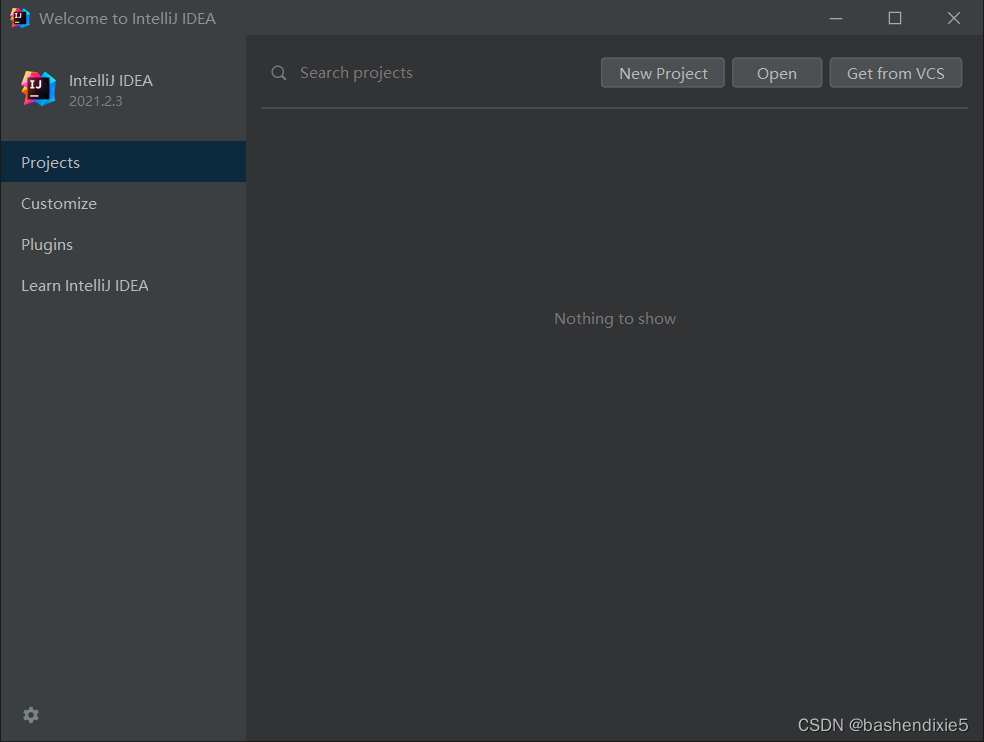
左侧选择Spring Initializr,填写右侧的相关信息。
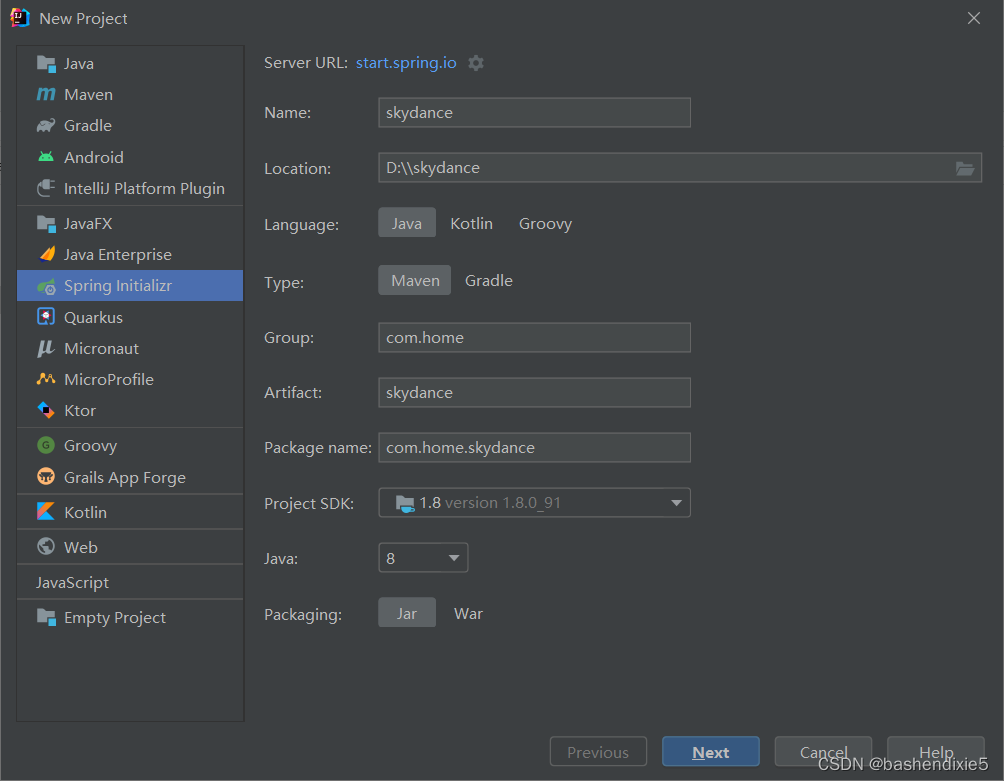
选择需要的包,主要是mybatis和mysql driver,spring-boot-starter-web等等,缺了也没关系,可以在项目内再添加。
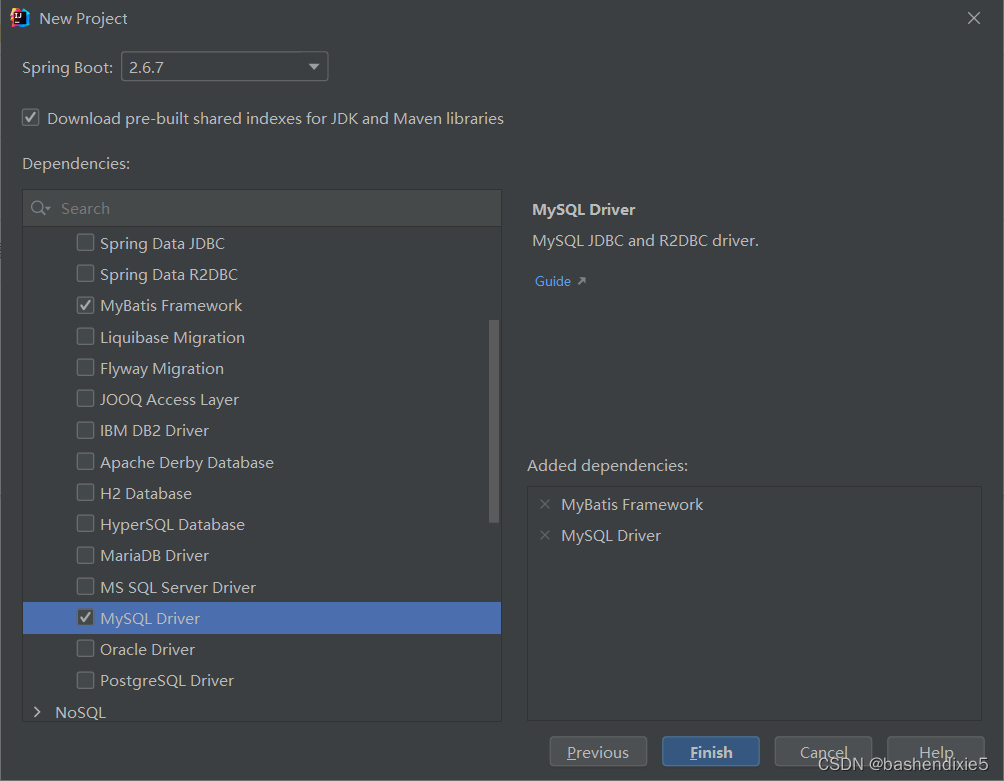
上面信息填完后,点finish,然后项目结构如下图左侧,并且maven开始添加需要的包,耐心等待。
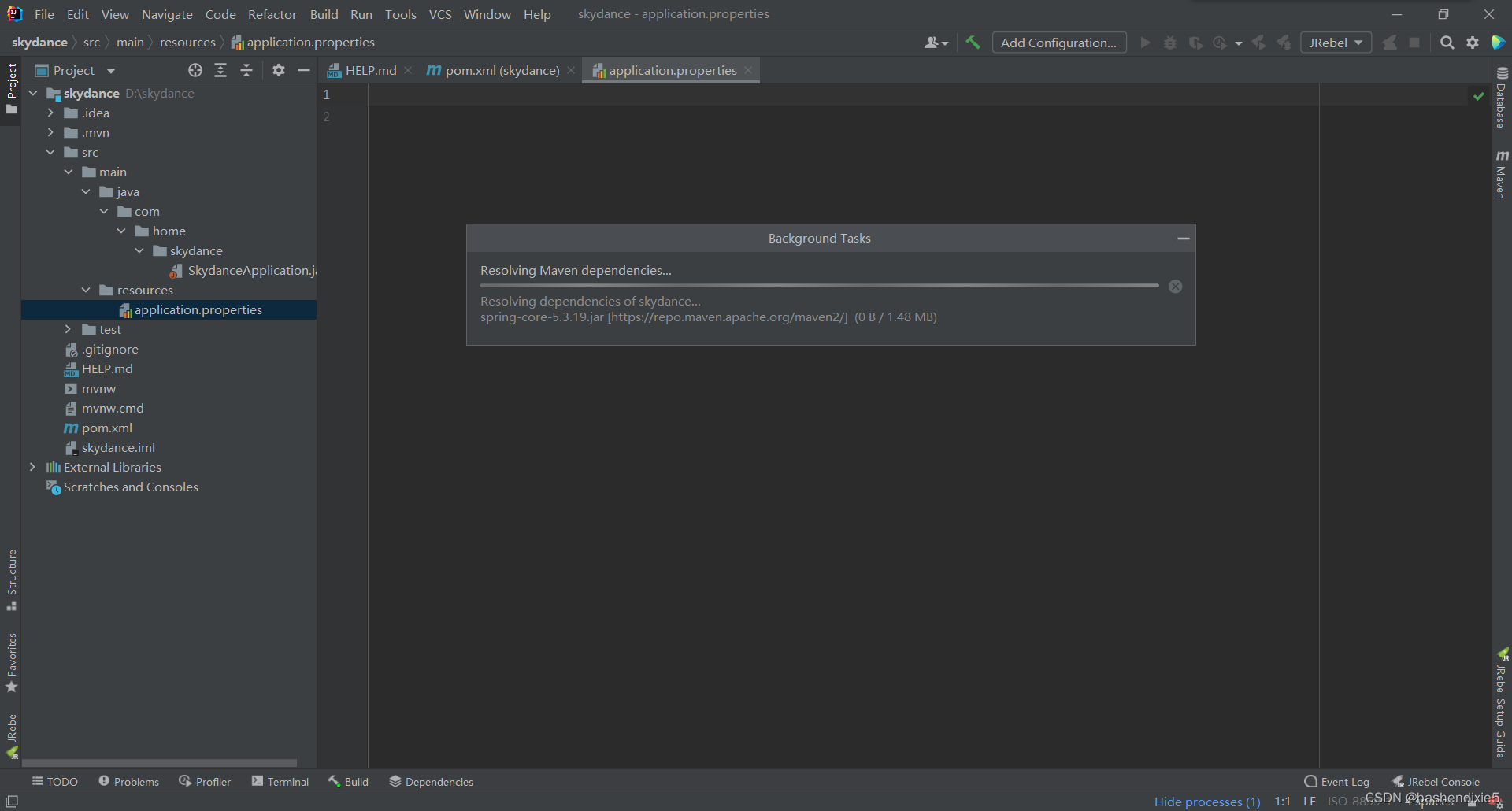
三、添加相应代码
1、pom.xml完整内容
<?xml version="1.0" encoding="UTF-8"?>
<project xmlns="http://maven.apache.org/POM/4.0.0" xmlns:xsi="http://www.w3.org/2001/XMLSchema-instance"
xsi:schemaLocation="http://maven.apache.org/POM/4.0.0 https://maven.apache.org/xsd/maven-4.0.0.xsd">
<modelVersion>4.0.0</modelVersion>
<parent>
<groupId>org.springframework.boot</groupId>
<artifactId>spring-boot-starter-parent</artifactId>
<version>2.6.7</version>
<relativePath/> <!-- lookup parent from repository -->
</parent>
<groupId>com.home</groupId>
<artifactId>skydance</artifactId>
<version>0.0.1-SNAPSHOT</version>
<name>skydance</name>
<description>skydance</description>
<properties>
<java.version>1.8</java.version>
</properties>
<dependencies>
<dependency>
<groupId>org.mybatis.spring.boot</groupId>
<artifactId>mybatis-spring-boot-starter</artifactId>
<version>2.2.2</version>
</dependency>
<dependency>
<groupId>org.springframework.boot</groupId>
<artifactId>spring-boot-starter-web</artifactId>
</dependency>
<dependency>
<groupId>mysql</groupId>
<artifactId>mysql-connector-java</artifactId>
<scope>runtime</scope>
</dependency>
<dependency>
<groupId>org.springframework.boot</groupId>
<artifactId>spring-boot-starter-test</artifactId>
<scope>test</scope>
</dependency>
<dependency>
<groupId>org.junit.platform</groupId>
<artifactId>junit-platform-commons</artifactId>
</dependency>
</dependencies>
<build>
<plugins>
<plugin>
<groupId>org.springframework.boot</groupId>
<artifactId>spring-boot-maven-plugin</artifactId>
</plugin>
</plugins>
<resources>
<resource>
<directory>src/main/resources</directory>
<includes>
<include>**/*.properties</include>
<include>**/*.xml</include>
</includes>
<filtering>true</filtering>
</resource>
<resource>
<directory>src/main/java</directory>
<includes>
<include>**/*.properties</include>
<include>**/*.xml</include>
</includes>
<filtering>true</filtering>
</resource>
</resources>
</build>
</project>2、配置文件properties
这里使用application.properties,而没使用yml。主要配置内容如下
server.port=9001
spring.datasource.url=jdbc:mysql://127.0.0.1:3306/world?&serverTimezone=Asia/Shanghai&useUnicode=true&characterEncoding=utf8&useSSL=false&allowMultiQueries=true
spring.datasource.username=root
spring.datasource.password=123456
spring.datasource.driver-class-name=com.mysql.cj.jdbc.Driver
mybatis.mapper-locations=classpath:com/home/skydance/dao/*.xml第1行指定了运行的端口。
第2行指定了数据库的连接url。
地址/端口/数据库名称:jdbc:mysql://127.0.0.1:3306/world
指定时区:serverTimezone=Asia/Shanghai
指定编码:useUnicode=true
指定字符集:characterEncoding=utf8
禁用SSLuseSSL=false
开启批量执行sql:allowMultiQueries=true
第3、4行指定了数据库的账号密码,这里没有进行加密,也没有创建新用户,不是一个好习惯。
第5行指定了驱动包。
第6行指定了mybatis,mapper的包路径。
3、项目结构
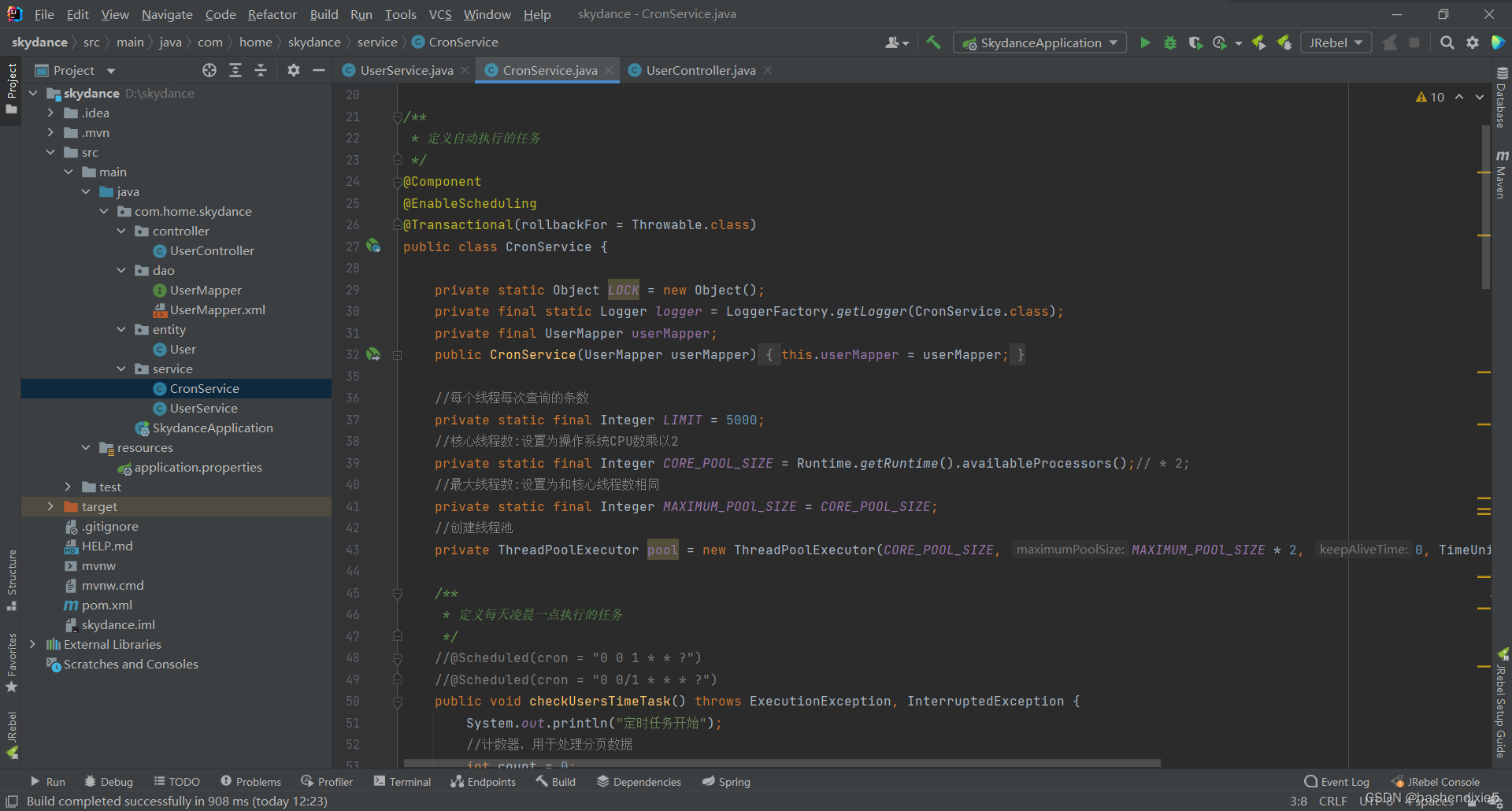
4、数据表结构
一张模拟任务的简单的表,定时任务主要是要读取当天的数据计算svd_value,然后更新回数据库。

5、定时任务参考代码
我们创建一个名称为CronService的文件。使用Scheduled开启定时任务。
package com.home.skydance.service;
import com.home.skydance.dao.UserMapper;
import com.home.skydance.entity.User;
import org.slf4j.Logger;
import org.slf4j.LoggerFactory;
import org.springframework.scheduling.annotation.EnableScheduling;
import org.springframework.stereotype.Component;
import org.springframework.transaction.annotation.Transactional;
import org.springframework.util.CollectionUtils;
import java.time.LocalDate;
import java.time.LocalDateTime;
import java.time.LocalTime;
import java.time.ZoneId;
import java.util.ArrayList;
import java.util.Date;
import java.util.List;
import java.util.concurrent.*;
/**
* 定义自动执行的任务
*/
@Component
@EnableScheduling
@Transactional(rollbackFor = Throwable.class)
public class CronService {
private static Object LOCK = new Object();
private final static Logger logger = LoggerFactory.getLogger(CronService.class);
private final UserMapper userMapper;
public CronService(UserMapper userMapper) {
this.userMapper = userMapper;
}
//每个线程每次查询的条数
private static final Integer LIMIT = 5000;
//核心线程数
private static final Integer CORE_POOL_SIZE = Runtime.getRuntime().availableProcessors();// * 2;
//最大线程数
private static final Integer MAXIMUM_POOl_SIZE = CORE_POOL_SIZE;
//创建线程池
private ThreadPoolExecutor pool = new ThreadPoolExecutor(CORE_POOL_SIZE, MAXIMUM_POOl_SIZE * 2, 0, TimeUnit.SECONDS, new LinkedBlockingQueue<>(100));
/**
* 定义每天凌晨一点执行的任务
*/
@Scheduled(cron = "0 0 1 * * ?")
//@Scheduled(cron = "0 0/1 * * * ?")
public void checkUsersTimeTask() throws ExecutionException, InterruptedException {
System.out.println("定时任务开始");
//计数器,用于处理分页数据
int count = 0;
//获取所有待处理数据总数
Integer total = userMapper.countPreRecordsByDate(getMaxCurrentDate());
logger.info("待处理数据条数:{}", total);
//计算需要多少轮才能处理完
int num = total / (LIMIT * CORE_POOL_SIZE) + 1;
logger.info("要经过的轮数:{}", num);
//统计处理成功的数据条数
int finishCount = 0;
for (int i = 0; i < num; i++)
{
logger.info("第" + (i+1) + "轮开始");
//接收线程返回结果
List<Future<Integer>> futureList = new ArrayList<>(32);
//起CORE_POOL_SIZE个线程并行查询更新库,加锁
for (int j = 0; j < CORE_POOL_SIZE; j++) {
synchronized (LOCK) {
int start = count * LIMIT;
count++;
//提交线程,用数据起始位置标识线程
Future<Integer> future = pool.submit(new MarkDataTask(start, LIMIT));
//先不取值,防止阻塞,放进集合
futureList.add(future);
}
}
//统计处理成功的数据
for (Future f : futureList) {
finishCount = finishCount + (int)f.get();
}
logger.info("第" + (i+1) + "轮结束");
}
logger.info("当天定时任务完成,预处理数据:{},处理成功:{}", total, finishCount);
System.out.println("定时任务结束");
}
public static Date getMaxCurrentDate() {
LocalDate localDate = LocalDate.now(); //获取今天的日期
//LocalDate yesterday = localDate.plusDays(-1); //前一天日期是今天减1
LocalDate yesterday = localDate;
LocalDateTime startTime = LocalDateTime.of(yesterday, LocalTime.MIN);
LocalDateTime endTime = LocalDateTime.of(yesterday, LocalTime.MAX);
return Date.from(endTime.atZone(ZoneId.systemDefault()).toInstant());
}
/**
* 批量处理数据线程类
*/
class MarkDataTask implements Callable<Integer> {
int start;
int limit;
MarkDataTask(int start, int limit) {
this.start = start;
this.limit = limit;
}
@Override
public Integer call() {
//设置线程名字
Thread.currentThread().setName("Thread" + start);
int count = 0;
//获取当前线程需要处理的数据
List<User> usersList = userMapper.selectByDateTime(getMaxCurrentDate(), start, limit);
if (CollectionUtils.isEmpty(usersList)) {
return count;
}
logger.info("操作第:[{},{}]数据", start, ""+(start + limit));
// 这里进行处理数据并更新数据库开始
for(int i=0; i<usersList.size(); i++)
{
usersList.get(i).setSvdValue(usersList.get(i).getId() * 3 - 3);
usersList.get(i).setThreadNo(Thread.currentThread().getName());
usersList.get(i).setUpdateTime(new Date());
}
// 这里进行处理数据并更新数据库结束
userMapper.updateForeach(usersList);
logger.info("操作第:[{},{}]数据完成!", start, start + limit);
return usersList.size();
}
}
}
四、完整代码
java_example/skydance at main · bashendixie/java_example · GitHubContribute to bashendixie/java_example development by creating an account on GitHub. https://github.com/bashendixie/java_example/tree/main/skydance
https://github.com/bashendixie/java_example/tree/main/skydance
最后
以上就是欢呼宝马最近收集整理的关于Java Demo示例:多线程定时执行批量任务一、目标任务概述二、项目创建三、添加相应代码四、完整代码的全部内容,更多相关Java内容请搜索靠谱客的其他文章。








发表评论 取消回复